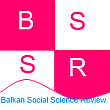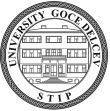Structure and Agency during Transition: Labor Representation Strength in Slovenia and Serbia
Abstract
This paper makes an overview and summarizes previous findings within the literature on labor representation strength during transition for two post-Yugoslavian cases, Slovenia and Serbia. Even though both countries shared the same socialist legacy of self-management and relative labor strength during socialism, they ended up as opposite cases of labor representation strength during transition, Slovenia being a case of labor representation success, while Serbia a case of labor representation weakness. The main aim of this paper is to show how different transitional trajectories led to profoundly different outcomes in terms of labor representation strength. In terms of theory, this paper utilizes structure and agency centered approaches in explaining the polar outcomes.
Downloads
References
Crowley, Stephen, Ost, David ed. 2001. Workers after Workers' States - Labor and Politics in Postcommunist Eastern Europe, Rowman and Littlefield Publishers, inc.
Crowley, Stephen.2004. Explaining Labor Weakness in Post-Communist Europe: Historical Legacies and Comparative Perspective, East European Politics and Societies 18: 394 DOI: 10.1177/0888325404267395
Dimitrova, Dimitrina, Vilrokx, Jacques. 2005.Trade Union Strategies in Central and Eastern Europe: Towards Decent Work, International Labour Organization
Eurofound. 2002. The development and current situation of trade unions, Retrieved at http://www.eurofound.europa.eu/eiro/2002/10/feature/si0210102f.htm on 01.04.2013
Eurofound.2012. Serbia: Industrial relations profile, European Foundation for the Improvement of Living and Working Conditions Retrieved at: http://www.eurofound.europa.eu/eiro/country/serbia.pdf on 01.04.2013
Grdesic, Marko.2008. Mapping the Paths of the Yugoslav Model: Labour Strength and Weakness in Slovenia, Croatia and Serbia, European Journal of Industrial Relations, 14:133 DOI: 10.1177/0959680108089187
Đukić, Petar. 2006. The organized world of labor in Serbia today: between economic reforms and populism, SEER SouthEast Europe Review for Labour and Social Affairs, 04:1130
Kohl,Heribert. 2009. Social dialogue, workers’ rights and freedom of association in the western Balkans survey after a first round of empirical research, SEER SouthEast Europe Review for Labour and Social Affairs, 2:151173
Ost, David. 2005. The Defeat of solidarity, Anger and Politics in Post-communist Europe, Cornell University Press
Paul J. Kubicek.2004. Organized Labor in Poscommunist States, From Solidarity to Infirmity, University of Pittsburgh Press
Stanojevic, Miroslav. 1999. Successful immaturity – communist legacies in the market context, SEER SouthEast Europe Review for Labour and Social Affairs, 4:4155
Stanojević, M.2003a.Formation of the Slovenian pattern: the strike wave and industrial relations 'rigidities', SEER, 6 (3):17-30
Stanojevic, Miroslav. 2003b.Workers’ Power in Transition Economies: The Cases of Serbia and Slovenia, European Journal of Industrial Relations, SAGE ISSN 0959-6801, 9 (3): 283–301
Tibor Mesman. 2012. Strategic Choices during System Change: Peak Level Unions and Their Struggles for Political Relevance in Post-Socialist Slovenia, Serbia and Poland, A Doctoral Dissertation Submitted to the Central European University, Doctoral School of Political Science, Public Policy, and International Relations
Upchurch, Martin.2006. Strategic dilemmas for trade unions in transformation: the experience of Serbia, SEER SouthEast Europe Review for Labour and Social Affairs, 4: 4364
Varga, Mihai. 2011. Striking with tied hands: Strategies of labor interest representation in post-communist Romania and Ukraine, Faculty Faculty of Social and Behavioural Sciences, institutional repository of the University of Amsterdam (UvA)
Permissions
Authors are expected to obtain permission from copyright holders for reproducing any illustrations, tables, figures or lengthy quotations previously published elsewhere. BSSR will not be held accountable for any copyright infringement caused by the authors.
Copyright
The content offered in the BSSR remains the intellectual property of the authors and their publishers respectively. University “Goce Delcev”- Shtip, R. Macedonia and BSSR keap the right to promote and re-publish the texts.



